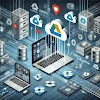The Remote Work Revolution: What You Need to Know
Remote work has transitioned from a temporary arrangement during the pandemic to a long-term or even permanent fixture for many companies. This shift presents both opportunities and challenges:
Cloud-Based Tools and Collaboration: Remote teams increasingly rely on cloud-based tools for communication, project management, and file sharing. While these tools facilitate collaboration and flexibility, they also introduce potential security risks if not properly managed.
Diverse Work Environments: Remote work occurs in various settings, including home offices, co-working spaces, and public locations with public Wi-Fi. Each of these environments poses different security risks, from unsecured networks to potential physical security breaches.
Privacy Concerns: The blending of personal and professional lives on the same devices raises privacy concerns. Protecting sensitive work-related data also involves safeguarding personal information, making comprehensive security measures crucial.
To explore how technology impacts your daily life and productivity, you might find our article on The Ultimate Guide to Creating a Productive Home Office helpful.
Key Strategies for Enhancing Cybersecurity in Remote Work
Implementing robust cybersecurity measures is essential for protecting remote work environments from various threats. Here are some key strategies to enhance cybersecurity:
1. Implement Strong Access Controls
Access control is the first line of defense in protecting remote work environments. Implement the following measures to secure access:
Multi-Factor Authentication (MFA): MFA adds an extra layer of security by requiring users to provide multiple forms of verification before gaining access. This could include a combination of passwords, biometric data, or one-time codes sent to mobile devices.
Virtual Private Networks (VPNs): VPNs encrypt internet connections, providing a secure tunnel for data transmission between remote workers and the company network. Ensure all remote employees use a reliable VPN service to protect their online activities.
Role-Based Access Control (RBAC): Implement RBAC to restrict access to sensitive data and systems based on employees' roles. This minimizes the risk of unauthorized access and reduces the potential impact of a security breach.
2. Keep Software and Systems Updated
Regular software updates and patches are critical for maintaining security. Here's how to ensure your systems stay protected:
Automatic Updates: Enable automatic updates for operating systems, applications, and security software to ensure that the latest security patches are applied promptly.
Patch Management: Establish a patch management policy to track and deploy updates across all devices and systems. Regularly review and prioritize updates based on their security impact.
Vulnerability Scanning: Use vulnerability scanning tools to identify and address potential weaknesses in your systems before they can be exploited by attackers.
For additional tips on optimizing your digital workspace, check out our guide on The Top Software and Apps to Boost Your Productivity.
3. Encrypt Sensitive Data
Data encryption is essential for protecting sensitive information from unauthorized access. Implement the following encryption practices:
End-to-End Encryption: Use end-to-end encryption for communications and file transfers to ensure that only the intended recipients can access the content. This applies to emails, messaging apps, and cloud storage services.
Device Encryption: Enable encryption on all devices used for remote work, including laptops, smartphones, and tablets. This protects data in case of device theft or loss.
Data Backup and Recovery: Regularly back up encrypted data to secure locations. Implement a data recovery plan to quickly restore information in the event of a breach or hardware failure.
4. Secure Cloud-Based Tools and Services
Cloud-based tools and services are integral to remote work, but they can pose security risks if not properly managed. Here's how to secure them:
Access Controls and Permissions: Set up granular access controls and permissions for cloud services to ensure that only authorized users can access and modify sensitive data. Regularly review and update these permissions as needed.
Secure Configuration: Follow best practices for configuring cloud services, including disabling unnecessary features, enabling encryption, and applying security patches.
Regular Audits: Conduct regular security audits of cloud-based tools to identify potential vulnerabilities and ensure compliance with security policies.
For more tips on optimizing your technology setup, our article on 10 Essential Software and Apps to Enhance Your Workflow offers valuable insights.
Best Practices for Privacy in Remote Work
Maintaining privacy is crucial in a remote work environment, where personal and professional data often intersect. Here are some best practices to enhance privacy:
1. Secure Personal Devices
Personal devices used for remote work should be secured to protect sensitive information:
Use Strong Passwords: Ensure that all devices are protected by strong, unique passwords. Avoid using easily guessable passwords and consider using a password manager to generate and store complex passwords.
Enable Device Locking: Set up automatic locking and password protection on all devices to prevent unauthorized access if the device is left unattended.
Install Security Software: Use reputable security software to protect against malware, viruses, and other threats. Regularly update the software to ensure optimal protection.
2. Educate Employees on Privacy Practices
Training employees on privacy best practices is essential for maintaining a secure remote work environment:
Data Handling Policies: Educate employees on proper data handling procedures, including how to securely store and dispose of sensitive information.
Secure Communication: Encourage the use of secure communication channels for discussing sensitive topics. Avoid using unsecured platforms or sharing confidential information through email.
Social Engineering Awareness: Train employees to recognize and respond to social engineering attacks, such as phishing and pretexting. Regularly reinforce these practices through awareness campaigns and simulations.
3. Manage Remote Work Environments
Remote work environments should be managed to ensure both security and privacy:
Secure Home Networks: Advise employees to secure their home networks with strong passwords and encryption. Avoid using public Wi-Fi for work-related activities whenever possible.
Physical Security: Encourage employees to maintain physical security in their remote workspaces. This includes locking devices when not in use and using privacy screens to prevent unauthorized viewing of sensitive information.
Compliance and Legal Considerations: Ensure that remote work practices comply with relevant data protection regulations and industry standards. Regularly review and update policies to address any changes in legal requirements.
For more insights into creating an efficient and secure work environment, explore our article on Must-Have Software and Apps for Remote Work.
Future Trends in Remote Work Security
Looking ahead, several trends are expected to shape the future of remote work security:
AI and Machine Learning in Cybersecurity: Artificial intelligence and machine learning will play an increasingly important role in identifying and mitigating cyber threats. These technologies can analyze vast amounts of data to detect anomalies and predict potential attacks.
Enhanced Privacy Regulations: As privacy concerns grow, expect more stringent regulations and standards to be implemented. Organizations will need to stay informed and adapt to new legal requirements to ensure compliance.
Integration of Security and Productivity Tools: Future security solutions will likely integrate more seamlessly with productivity tools, offering a more cohesive approach to managing both security and efficiency.
Increased Focus on Employee Training: Ongoing education and training will remain crucial for addressing emerging threats and maintaining a secure remote work environment. Organizations will invest more in training programs to keep employees informed and prepared.
Conclusion
Securing remote work environments requires a multi-faceted approach that addresses both cybersecurity and privacy concerns. By implementing strong access controls, keeping software updated, encrypting data, and following best practices for privacy, organizations and individuals can protect sensitive information and ensure a secure remote work experience. As remote work continues to evolve, staying informed about emerging threats and adopting proactive security measures will be key to maintaining a safe and productive work environment.
For additional resources on enhancing your tech setup and productivity, check out our articles on Exploring the Best Budget Gadgets of 2024 and The Ultimate List of Must-Have Software.
By staying vigilant and proactive, you can navigate the challenges of remote work and maintain a secure and efficient work environment.








